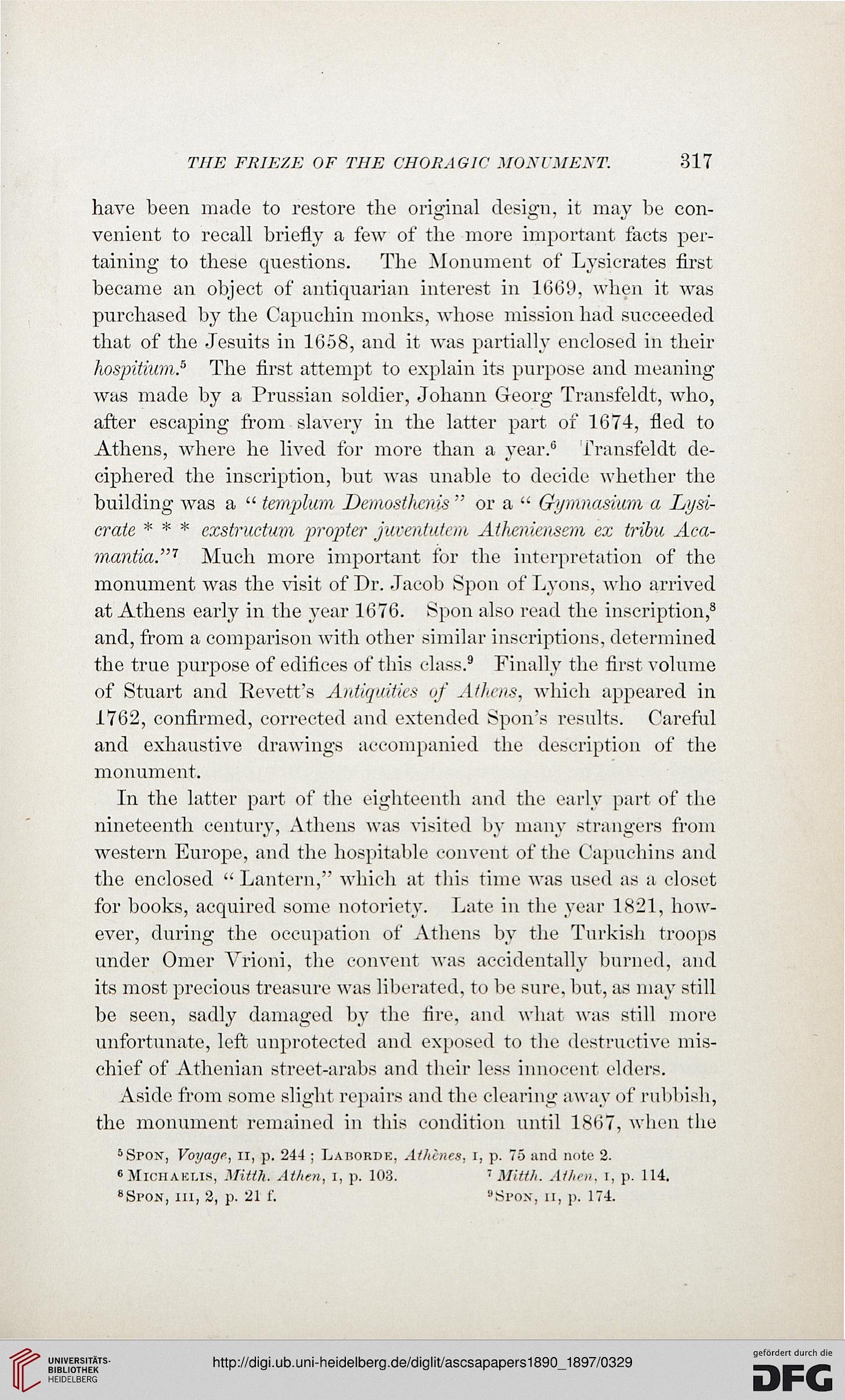THE FRIEZE OF THE CHORAGIC MONUMENT.
317
have been made to restore the original design, it may he con-
venient to recall briefly a few of the more important facts per-
taining to these questions. The Monument of Lysicrates first
became an object of antiquarian interest in 1669, when it was
purchased by the Capuchin monks, whose mission had succeeded
that of the Jesuits in 1658, and it was partially enclosed in their
hospitium.5 The first attempt to explain its purpose and meaning
was made by a Prussian soldier, Johann Georg Transfeldt, who,
after escaping from slavery in the latter part of 1674, fled to
Athens, where he lived for more than a year.6 Transfeldt de-
ciphered the inscription, but was unable to decide whether the
building was a " templum Demosthcnis " or a " Gymnasium a Lysi-
crate * * * exstructum 'propter juventutem Atheniensem ex tribu Aca-
mantia."7 Much more important for the interpretation of the
monument was the visit of Dr. Jacob Spon of Lyons, who arrived
at Athens early in the year 1676. Spon also read the inscription,8
and, from a comparison with other similar inscriptions, determined
the true purpose of ediflces of this class.9 Finally the first volume
of Stuart and Revett's Antiquities of Athens, which appeared in
1762, confirmed, corrected and extended Spoil's results. Careful
and exhaustive drawings accompanied the description of the
monument.
In the latter part of the eighteenth and the early part of the
nineteenth century, Athens was visited by many strangers from
western Europe, and the hospitable convent of the Capuchins and
the enclosed " Lantern," which at this time was used as a closet
for books, acquired some notoriety. Late in the year 1821, how-
ever, during the occupation of Athens by the Turkish troops
under Omer Vrioni, the convent was accidentally burned, and
its most precious treasure was liberated, to be sure, but, as may still
be seen, sadly damaged by the fire, and what was still more
unfortunate, left unprotected and exposed to the destructive mis-
chief of Athenian street-arabs and their less innocent elders.
Aside from some slight repairs and the clearing away of rubbish,
the monument remained in this condition until 1867, when the
5Spon, Voyage., ii, p. 244 ; Laborde, Aihines, i, p. 75 and note 2.
6 Michaki.is, Mitth. Athen, i, p. 103. 7 Mitth. Aiken, i, p. 114.
8Si'on, in, 2, p. 21 f. "Spo.v, ii, p. 174.
317
have been made to restore the original design, it may he con-
venient to recall briefly a few of the more important facts per-
taining to these questions. The Monument of Lysicrates first
became an object of antiquarian interest in 1669, when it was
purchased by the Capuchin monks, whose mission had succeeded
that of the Jesuits in 1658, and it was partially enclosed in their
hospitium.5 The first attempt to explain its purpose and meaning
was made by a Prussian soldier, Johann Georg Transfeldt, who,
after escaping from slavery in the latter part of 1674, fled to
Athens, where he lived for more than a year.6 Transfeldt de-
ciphered the inscription, but was unable to decide whether the
building was a " templum Demosthcnis " or a " Gymnasium a Lysi-
crate * * * exstructum 'propter juventutem Atheniensem ex tribu Aca-
mantia."7 Much more important for the interpretation of the
monument was the visit of Dr. Jacob Spon of Lyons, who arrived
at Athens early in the year 1676. Spon also read the inscription,8
and, from a comparison with other similar inscriptions, determined
the true purpose of ediflces of this class.9 Finally the first volume
of Stuart and Revett's Antiquities of Athens, which appeared in
1762, confirmed, corrected and extended Spoil's results. Careful
and exhaustive drawings accompanied the description of the
monument.
In the latter part of the eighteenth and the early part of the
nineteenth century, Athens was visited by many strangers from
western Europe, and the hospitable convent of the Capuchins and
the enclosed " Lantern," which at this time was used as a closet
for books, acquired some notoriety. Late in the year 1821, how-
ever, during the occupation of Athens by the Turkish troops
under Omer Vrioni, the convent was accidentally burned, and
its most precious treasure was liberated, to be sure, but, as may still
be seen, sadly damaged by the fire, and what was still more
unfortunate, left unprotected and exposed to the destructive mis-
chief of Athenian street-arabs and their less innocent elders.
Aside from some slight repairs and the clearing away of rubbish,
the monument remained in this condition until 1867, when the
5Spon, Voyage., ii, p. 244 ; Laborde, Aihines, i, p. 75 and note 2.
6 Michaki.is, Mitth. Athen, i, p. 103. 7 Mitth. Aiken, i, p. 114.
8Si'on, in, 2, p. 21 f. "Spo.v, ii, p. 174.




